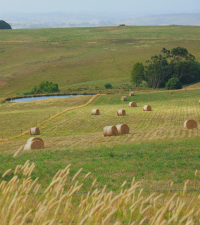Automated Carbon Accounting for Scopes 1, 2 and 3: Impact Reduction Strategies
January 9, 2024

Enterprise carbon accounting has historically relied on average data methods and generalized emissions factors.
For the food industry, where Scope 3 emissions generally comprise over 80% of a company’s total emissions, this poses a notable risk. Measuring agricultural emissions within Scope 3 is a uniquely complex process and emissions are highly variable.
Traditional methodologies frequently put companies in the position of choosing between comprehensive corporate accounting or more granular product carbon footprinting. Corporate accounting was being done for reporting purposes, but operating without granular insights meant there were no metrics on which to build actionable, impactful strategies.
By using full-scope GHG reporting tools and accessing product carbon footprinting at scale, food companies can now achieve a more accurate reflection of their corporate footprint and can effectively forecast and strategize toward reduction.
Challenges and Shifts in Climate Regulations
Increasing pressure from the evolving regulatory landscape – including the implementation of EU mandates, the new California climate laws, and the proposed SEC climate disclosures – is bringing new urgency for companies to demonstrate progress on impact reduction.
Media and public attention no longer focus only on corporate net-zero statements and reporting efforts, but on closely analyzing which companies demonstrate real progress on reduction and impact – and which do not.
These complexities are pushing companies within the food industry to seek sustainability solutions that are more cost-effective, provide dynamic data, and support actionable strategies across team functions.
With over 17 years of agricultural production research and the world’s largest database for product and ingredient sustainability, HowGood’s team is uniquely positioned to provide guidance.
In this article, we cover the complexities of measuring supply chain emissions in the food industry, the challenges particular to Scope 3 measurement and management, and the newest tools for developing robust end-to-end GHG tracking and reduction strategies.
Overview of Scopes 1, 2, and 3 for Food Companies
The categorization of emissions into Scopes 1, 2 and 3 provides the framework for comprehensive carbon accounting, essential for effective ESG (Environmental, Social, and Governance) reporting.
Scopes 1, 2 and 3 emissions classifications were developed by the Greenhouse Gas Protocol (GHGP), a global framework established through a partnership between the World Resources Institute (WRI) and the World Business Council for Sustainable Development (WBCSD), of which HowGood is an active member.
Introduced in the early 2000s, these scopes provide a comprehensive, standardized method for organizations to measure and manage their greenhouse gas emissions.
- Scope 1 covers direct emissions from owned or controlled sources.
- Scope 2 accounts for indirect emissions from the generation of purchased electricity, steam, heating, and cooling consumed by the reporting company.
- Scope 3 is the most significant contributor in the food industry, encompassing all other indirect emissions that occur across a company’s value chain, including both upstream and downstream activities
This classification framework has become integral to corporate sustainability reporting in the US and the EU. It helps businesses identify and comprehensively strategize their climate impact mitigation efforts.
Scope 1: Direct emissions
Scope 1 emissions are direct emissions originating from sources that are owned or controlled by the company. Examples include emissions from food processing facilities, and from company-owned or controlled transport vehicles and machinery.
Accurate calculation and accounting of these Scope 1 emissions is critical for food companies. It allows them to identify the most significant sources of their owned greenhouse gas emissions and to develop targeted plans for reduction.
Strategies might include investing in energy-efficient technologies, transitioning to renewable energy sources for production processes, or adopting company-wide onsite sustainability policies.
Scope 2: Indirect emissions from purchased energy
Scope 2 emissions in the food industry are indirect emissions resulting from the purchase of electricity, heat, steam, or other forms of energy. These emissions occur at the place where the energy is generated and are therefore not direct emissions of the food company. However, they are a consequence of the company’s energy consumption and are integral to its overall carbon footprint.
To manage Scope 2 emissions, food companies must assess their energy usage, including the energy used in manufacturing processes, refrigeration, and running office buildings. These can be quantified by applying emission factors specific to a company’s energy sources and regions.
Strategies to reduce Scope 2 emissions often involve shifting to renewable energy sources, improving energy efficiency, and engaging in energy purchase agreements that support sustainable energy projects.
Scope 3: All other indirect emissions
Scope 3 emissions present both the most significant challenge and the greatest opportunity for impact in the food industry.
These emissions are all indirect and not covered under Scope 2, occurring both upstream in the supply chain (like agriculture and procurement) and downstream (such as product distribution, use, and end-of-life disposal).
Accurately measuring Scope 3 emissions is challenging due to the extensive and complex nature of food supply chains. It requires a comprehensive approach, often involving the collection and analysis of data from multiple sources. Companies must either utilize a granular ingredient emissions database or collaborate with suppliers, distributors, and customers to gain visibility into the entire lifecycle of their products.
Effective management of Scope 3 emissions might involve engaging suppliers in sustainability initiatives, innovating product formulas for reduced environmental impact, and implementing more sustainable packaging and distribution methods. Advanced carbon footprinting solutions, like HowGood’s Latis platform, track and analyze data across the supply chain. The right tools are invaluable for Scope 3 measurement and management efforts, providing insights to drive meaningful reductions in the overall carbon footprint of food companies.
“In order to demonstrate a reduction in scope 3 emissions, food companies must measure and report on their GHG emissions with enough granularity – including crop- and location-specific emissions factors – to show the impact when improvements are made. Without this level of granularity, it is very difficult to reflect the result of any sustainability efforts."
Scope 3 presents the largest emissions measurement challenge for food companies. Here’s why:
- Indirect sources: Their indirect nature and the fact that they’re an aggregate from multiple points across the supply chain has made them difficult to quantify and manage effectively in the past.
- Evolving regulations and impact: The challenge is amplified by evolving regulations that are creating more stringent reporting requirements for Scope 3 emissions. In addition, requirements vary depending on factors like the company’s type, size, and operational regions.
- Inadequacy of traditional methods: Traditional methodologies, such as using industry-average emission factors or spend-based calculations, are becoming increasingly inadequate. They often result in significant miscalculations by failing to capture the true emissions associated with specific sourcing practices.
- Broad scope for most food brands: The majority of food and consumer packaged goods (CPG) brands have extensive Scope 3 emissions to quantify, track, reduce and report.
The complexity of defining Scope 3 emissions varies significantly depending on a company’s position within the supply chain and their access to a granular emissions database. For those not involved in primary production or without vertical integration, Scope 3 encompasses everything from agricultural production to distribution and waste management. In contrast, for primary producers, activities like agricultural production would fall under direct Scope 1 emissions.
Most food and CPG brands fall into the former category. This means their Scope 3 emissions extend beyond processing and packaging to include on-farm practices, transportation, and more, reflecting their intricate and often global supply chains.
Regulatory Landscape in Relation to Scopes 1, 2, and 3 Reporting
Regulatory updates in the United States, the EU and other countries are indicating a move toward increasingly stringent sustainability reporting.
For example, the EU’s Corporate Sustainability Reporting Directive (CSRD) is one of several new regulations introduced under its commitment to get to net zero by 2050. Under the CSRD, large, listed companies are impacted and will need to begin reporting in 2025. In the US, proposed SEC climate disclosure rules would impact all public companies. California has already signed two new laws into existence that will impact any company operating within the state with more than $1 billion in revenue. Additional announcements this year included the International Sustainability Standards Board (ISSB) global sustainability disclosure standards, which are being adopted by the UK, Canada and Australia.
This push for transparency is not just a regulatory matter but also ties into the financial aspects of business operations. Studies have indicated that food companies with robust strategies to reduce sustainability risks tend to benefit from a lower cost of capital.
It’s becoming increasingly clear that comprehensive carbon emissions reporting and holistic assessments of a company’s impact at the product and ingredient level will soon be essential for attracting investors and maintaining a competitive edge.
Importance of End-to-End GHG Reporting Tools
This growing emphasis on transparency means food companies must be equipped for accurate end-to-end reporting on GHG emissions.
HowGood’s full-scope solution in the Latis platform consolidates and centralizes all sustainability data across an organization. This holistic approach ensures comprehensive coverage of Scopes 1, 2, and 3, streamlining the process to ensure companies are always compliance-ready.
By providing a visual breakdown of total emissions, HowGood enables food companies to clearly identify and understand which areas contribute most to their carbon footprint. Companies can then more strategically tackle carbon reduction, focusing first on their carbon-intensive hotspots.
As the world’s largest ingredient database, Latis provides the data needed to actively model the impact of various reduction opportunities, accelerating the identification of strategies with the biggest impact. This feature is particularly crucial in the context of Scope 3 emissions, where the complexity and scale of the supply chain can make identifying and implementing reduction strategies challenging.
HowGood’s end-to-end carbon accounting tool is not just about compliance and reporting – the granularity and food industry-specificity it offers powers actionable insights for meaningful carbon reduction.



.png)
